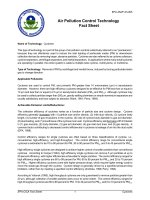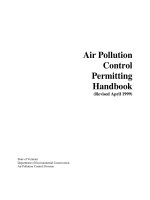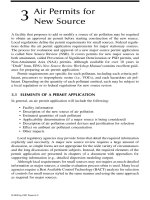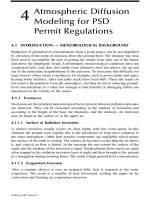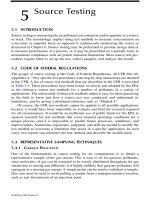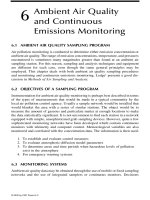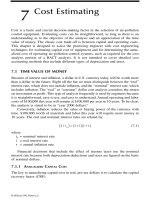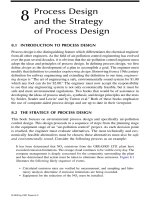AIR POLLUTION CONTROL TECHNOLOGY HANDBOOK - CHAPTER 2 ppsx
Bạn đang xem bản rút gọn của tài liệu. Xem và tải ngay bản đầy đủ của tài liệu tại đây (287.36 KB, 20 trang )
Clean Air Act
2.1 HISTORY OF THE CLEAN AIR ACT
The development and maturation of the Clean Air Act (CAA) in the U.S. demon-
strates an increasing federal role in the regulation of air pollution. Until the 1950s,
air pollution generally was perceived as a local and regional problem to be regulated
at the local and state levels. California was the first state to act against air pollution,
primarily because of deteriorating air quality in the already highly populated Los
Angeles basin area with its unique geography and meteorology that exacerbated the
problem.
The Air Pollution Control Act of 1955 authorized air pollution research and
training programs and technical assistance to state and local governments, but the
responsibility for air pollution control was left to state and local governments. The
Air Pollution Control Act was amended in 1961 and again in 1962 to authorize
special studies for health effects associated with motor vehicle pollutants.
The Clean Air Act was passed in 1963, establishing the first federal responsibility
for air pollution control. In addition to authorizing grant research and training and
technical assistance, federal enforcement authority was granted to abate interstate
air pollution control problems. Also, air quality criteria were required to be developed
for the protection of public health and welfare. The Motor Vehicle Air Pollution
Control Act of 1965 authorized the Department of Health, Education, and Welfare
to promulgate emission standards for motor vehicles, and the first federal emission
standards for light motor vehicles were established for the 1968 model year.
2.1.1 1970 C
LEAN
A
IR
A
CT
A
MENDMENTS
The 1970 Clean Air Act Amendments (CAAA) produced a dramatic change in
broadening the federal responsibility for air pollution control. It created the U.S.
Environmental Protection Agency (EPA), and it established the following programs
for new air quality standards:
• National Ambient Air Quality Standards (NAAQS)
• New Source Performance Standards (NSPS)
• National Emission Standards for Hazardous Air Pollutants (NESHAP)
• Citizen suits for enforcement
• New automobile emission standards
States were allowed to enforce the Clean Air Act by obtaining EPA approval of
a State Implementation Plan (SIP). An approved SIP is promulgated in the federal
regulations so that it is federally enforceable.
2
9588ch02 frame Page 13 Wednesday, September 5, 2001 9:40 PM
© 2002 by CRC Press LLC
2.1.1.1 National Ambient Air Quality Standards
The NAAQS for criteria pollutants were to be established by the EPA at two levels:
(1) primary standards to protect health, and (2) secondary standards to protect welfare
(e.g., crops, vegetation, buildings, visibility, etc.). Six criteria air pollutants were
specified, including:
• Particulate
• Carbon monoxide (CO)
• Ozone (O
3
)
• Sulfur dioxide (SO
2
)
• Nitrogen dioxide (NO
2
)
• Lead
Note that Volatile Organic Compounds (VOCs) are not a criteria pollutant, but
they are regulated like a criteria pollutant because VOCs and nitrogen oxides are
precursors to ozone, which is produced by photochemical reactions.
Specifying lead as a criteria pollutant instead of a hazardous air pollutant is
interesting, and this distinction proved to be effective. At that time, tetraethyl lead
was prevalent in leaded gasoline as an inexpensive way to boost the octane rating.
Controlling the spread of lead molecules throughout the environment as gasoline
was burned was accomplished effectively as a criteria pollutant. Conversely, the
hazardous air pollutant program, NESHAP, became bogged down in establishing
health-based standards.
The EPA was required to review the NAAQS every 5 years to ensure that new
research would be considered. The standard could remain at the same level if the
review proved that the standard provides sufficient protection for health and welfare.
2.1.1.2 New Source Performance Standards
The 1970 amendments established a program of technology-based NSPS so that any
new source of air pollution would be required to apply effective air pollution controls.
New Source Performance Standards can be found in the Code of Federal Regulations,
40 CFR Part 60. Existing sources were “grandfathered” and were not required to
retrofit pollution controls. Existing sources that are modified are considered new
sources, so old plants have to upgrade their air-pollution control equipment as the
plant is upgraded. The definition of “modified” is a subject of controversy to this
day, centering on the distinction between “modification” and “maintenance.”
1
2.1.1.3 Hazardous Air Pollutants
The NESHAP program for hazardous air pollutants required setting pollutant-spe-
cific, health-based standards for each hazardous air pollutant. Unfortunately, this
program turned out to be too cumbersome to be implemented effectively. One
significant problem was that the EPA administrator was to set the standard “at the
level which in his judgment provides an ample margin of safety to protect the public
from such hazardous pollutant.” First, it takes a great deal of research to establish
9588ch02 frame Page 14 Wednesday, September 5, 2001 9:40 PM
© 2002 by CRC Press LLC
a human health-based standard. Second, establishing an ample margin of safety was
problematic, especially for the portion of the public that is sensitive to air pollution.
It required court decisions to determine that cost of control could not be a factor in
determining a health-based standard, but cost could be used to establish an ample
margin of safety. Finally, establishing standards for over a hundred hazardous chem-
icals proved to be too burdensome. NESHAP standards were promulgated for only
the few hazardous pollutants listed in Table 2.1.
2.1.1.4 Citizen Suits
Determining that any person has sufficient interest to protect a universal resource
such as clean air, Congress established citizen suits that authorize civil action against
any person, including a government entity, who is alleged to be in violation of an
emission standard or limitation. It also authorized suits against the EPA administrator
when the administrator is alleged to fail to perform acts or duties required by the
Clean Air Act. Costs of litigation, including reasonable attorney and expert witness
fees, may be awarded. A key concept associated with citizen suits is the granting of
“standing” to any individual, corporation, state, or municipality, doing away with
the normal requirement of “injury in fact.”
There are procedural requirements to limit excessive use of citizen litigation.
One is providing 60 days notice of a violation to the EPA, state, and alleged violator
prior to starting a civil action. This is intended to allow agencies and violators the
opportunity to correct a problem. Another condition barring a citizen suit is that the
EPA or state has not already commenced and is not diligently pursuing a civil action.
Again, citizen suits come into play when the enforcement agencies fail to meet their
duties.
2.1.2 1977 C
LEAN
A
IR
A
CT
A
MENDMENTS
Two highlights of the 1977 Amendments were (1) codifying of the concept of
Prevention of Significant Deterioration (PSD); and (2) establishing an emission offset
policy in areas that are not in attainment of the NAAQS.
TABLE 2.1
Hazardous Air Pollutants for which
NESHAP Standards Were Established
Asbestos
Benzene
Beryllium
Inorganic arsenic
Mercury
Radionuclides
Radon-22
Vinyl chloride
Coke oven emissions (listed, but not promulgated)
9588ch02 frame Page 15 Wednesday, September 5, 2001 9:40 PM
© 2002 by CRC Press LLC
2.1.2.1 Prevention of Significant Deterioration
The concept of preventing an area with good air quality from deteriorating to a lesser
quality was introduced with the 1970 Amendments. However, the wording was thin
and controversy erupted. In 1973, the EPA proposed a plan for defining no significant
deterioration, and reproposed and adopted the concept in 1974. The 1977 Amend-
ments removed the controversy by codifying PSD.
Three classifications of geographical areas were established, with boundaries
initially set by the EPA. Changes could be made by state and local officials to allow
local determination of land use. Class I areas were designated to allow very little
deterioration of the existing air quality. Pristine areas were to remain pristine. These
areas include national parks and wilderness areas and many Indian reservations.
Class II areas allow a moderate decline from existing ambient air quality as growth
occurs. Class III areas are specifically designated as heavy industrial areas where a
larger amount of deterioration of the existing ambient air quality is allowed. In no
case are any areas allowed to have pollution levels that exceed the NAAQS, so if
the existing air quality is already poor, limited or no additional deterioration is
allowed.
Each area classification allows a specified incremental increase in the ambient
pollutant concentration above the ambient background level as of 1977. Thus, a
permanent cap is established, which may be lower than the NAAQS.
Any new major source of air emissions that proposes to locate in an area must
obtain a PSD air permit, which includes the projected increase in ambient pollutant
concentration. New Source Review (NSR) for PSD air permit applications is dis-
cussed in Chapter 3. An approved PSD air permit allots a portion of the available
increment for deterioration to that source. Later new sources wishing to locate in
the area must consider the amount of the increment that has already been consumed.
Air permitting agencies must consider reasonable increment consumption and pro-
jected growth in the area to avoid granting the increment spuriously on a “first come,
first served” basis.
2.1.2.2 Offsets in Non-Attainment Areas
A new air pollution source that wishes to locate in an area that does not meet the
NAAQS is precluded from doing so, unless a net decrease in air pollution can be
demonstrated. The proposed new source can agree to control or shut down emission
sources of like pollutant in exchange, in order to offset the new source of pollution.
To ensure that progress is made toward bringing the ambient air quality closer to
the NAAQS, the offset ratio must be greater than 1 to 1.
To avoid putting industry in the position of keeping old, dirty emission sources
operating to preserve offsets for future expansions, and to encourage emission
reductions, the offset policy was accompanied by banking. When emission reduc-
tions were made, emission reduction credits could be applied for and granted. Banked
emission reduction credits (ERC) could be used as offsets in the future. Under federal
guidance, credits were only good for a 5-year contemporaneous period, however.
Some state agencies, to which air permitting authority has been delegated by the
9588ch02 frame Page 16 Wednesday, September 5, 2001 9:40 PM
© 2002 by CRC Press LLC
EPA, use different contemporaneous periods. This is the type of discrepancy that
has led to confusion between federal and state authority and program implementation.
2.2 1990 CLEAN AIR ACT AMENDMENTS
The 1990 Clean Air Act Amendments made major, sweeping changes to the Act.
They have been hailed
2
as “one of the most significant pieces of environmental
legislation ever enacted.” There was significant and lengthy Congressional debate
throughout the 1980s as to how to address shortcomings of the Act, especially over
provisions for acid rain control and air toxics.
The previous CAAA fell short of their goal of achieving acceptable air quality
throughout the U.S. Indeed, every major urban area was in violation of at least one
of the NAAQS, affecting over 100 million people.
3
NESHAP had been promulgated
for only eight hazardous air pollutants in the 20 years since the program has been
established by the 1970 Amendments. The EPA estimated that 1000 to 3000 excess
cancer deaths per year were occurring as a result of hazardous air pollutants.
The political mandate for the 1990 Amendments was large. The U.S. House of
Representatives passed the Amendments by a vote of 401 to 21, and the Senate
voted in favor by 89 to 11.
The 1990 Amendments were organized in 11 Titles, as listed in Table 2.2. The
major changes include a completely overhauled hazardous air pollutant program
(Title III), specific provisions to control pollutants that cause acid rain (Title IV), a
new operating permit program (Title V), and a specific program to control pollutants
that cause stratospheric ozone depletion (Title VI).
Concerns about the effectiveness of implementing the 1990 Amendments still
remain. There are numberous deadlines that the EPA must meet, but few “statutory
hammers” or consequences to ensure that they are met. This opens the door to
resorting to lawsuits to force the EPA to meet the deadlines, diverting the EPA’s
budget resources to the defense of those lawsuits.
TABLE 2.2
1990 Clean Air Act Amendments
Title I Non-Attainment Areas
Title II Mobile Sources
Title III Hazardous Air Pollutants
Title IV Acid Rain
Title V Operating Permits
Title VI Stratospheric Ozone
Title VII Enforcement
Title VIII Miscellaneous Provisions
Title IX Research
Title X Disadvantaged Business
Title XI Employment Transition Assistance
9588ch02 frame Page 17 Wednesday, September 5, 2001 9:40 PM
© 2002 by CRC Press LLC
2.2.1 T
ITLE
I: P
ROVISIONS
FOR
A
TTAINMENT
AND
M
AINTENANCE
OF
N
ATIONAL
A
MBIENT
A
IR
Q
UALITY
S
TANDARDS
The 1990 CAAA recognized that many urban areas were not in attainment of the
NAAQS, and that there were major problems with high levels of tropospheric ozone,
carbon monoxide. To address the problems practically, the Amendments extended
the time for states to achieve compliance, but required constant progress in reducing
emissions and established provisions for sanctions on areas of the country that do
not meet the conditions.
The new amendments also established degrees of severity for non-attainment
for ozone, carbon monoxide, and particulate matter with an aerodynamic diameter
of less than 10 microns (PM
10
).
Ozone non-attainment was broken into five degrees of severity, as listed in
Table 2.3. Areas of extreme severity were allowed more time to achieve attainment,
but receive increased federal scrutiny for new source review of major sources. The
definition of “major” stationary source, discussed further in new source review
permit applications in the next chapter, applies to smaller sources, and the emission
offset ratio requirement for new sources is increased.
Carbon monoxide (CO) and particulate matter degrees of severity for non-
attainment were established at two levels as shown in Table 2.4.
2.2.1.1 NAAQS Revisions
Current NAAQS as of February 2001 are listed in Table 2.5. The Clean Air Act
requires that the EPA reviews all its air standards every 5 years to determine if new
TABLE 2.3
Degrees of Severity for Ozone Non-Attainment
1-h Avg.
Attainment
Date
Major Source Threshold
(tons/yr)
Offset Ratio
for New Sources
Marginal 0.12–0.138 11/15/93 100 1.1
Moderate 0.138–0.16 11/15/96 100 1.15
Serious 0.16–0.18 11/15/99 50 1.2
Severe 0.18–0.19 11/15/05 25 1.3
0.19–0.28 11/15/07
Extreme >0.28 11/15/10 10 1.5
TABLE 2.4
Degrees of Severity for CO and PM Non-Attainment
CO PM
Moderate 9–16.5 ppm Area that can achieve attainment by November 1996
Serious >16.5 ppm Area that cannot achieve compliance by November 1996
9588ch02 frame Page 18 Wednesday, September 5, 2001 9:40 PM
© 2002 by CRC Press LLC
studies and scientific evidence warrant revisions to the standards. In 1997, the EPA
issued a new primary and secondary ozone standard of 0.08 ppm for an 8-hour
average in addition to the existing standard of 0.12 ppm for a 1-hour average. The
EPA determined that longer-term exposures to lower levels of ozone caused health
effects including asthma attacks, breathing and respiratory problems, loss of lung
function, and possible long-term lung damage and decreased immunity to disease.
This was the first update of the ozone standard in 20 years.
Also in 1997, EPA established a new particulate matter standard for fine partic-
ulates with an aerodynamic diameter of less than 2.5 microns (PM
2.5
). The standard
was established at 65
µ
g/m
3
for a 24-hour average and 15
µ
g/m
3
for an annual
average. The new standards followed a lawsuit by the American Lung Association
that the EPA missed the deadline for the required review of the particulate standard.
The previous review of the particulate standard was conducted in 1987. A new court-
ordered deadline of July 1997 was established to finalize the particulate standard,
and the EPA finalized the ozone standard simultaneously.
In May 1999, the new ozone and particulate standards were remanded by the
Court of Appeals following a lawsuit by the American Trucking Association. The
key issue was neither the quality of the health-based review, the review process, nor
the degree of public health concern. Indeed, the Court of Appeals agreed that there
was growing empirical evidence demonstrating a relationship between fine particle
pollution and adverse health effects that justified a new fine particle standard. Instead,
the key issue centered around EPA’s authority to establish a standard for a “non-
threshold” pollutant that weighs health with the cost of implementing the standard.
A threshold pollutant is one that exhibits a minimum level, or threshold, below
which no health effects are observed. A non-threshold pollutant has diminishing
health effects with decreasing concentration, but there will always be some effect
TABLE 2.5
National Ambient Air Quality Standards
Primary
Secondary
Level Averaging Time Level Averaging Time
Ozone 0.12 ppm 1 h Ozone 0.12 ppm
PM-10 150
µ
g/m
3
24 h PM-10 150
µ
g/m
3
50
µ
g/m
3
1 yr. 50
µ
g/m
3
CO 35 ppm 1 h CO 35 ppm
9 ppm 8 h 9 ppm
SO
2
0.14 ppm 24 h SO
2
0.14 ppm
0.030 ppm 1 yr. 0.030 ppm
NO
2
0.053 ppm 1 yr. NO
x
0.053 ppm
Lead 1.5
µ
g/m
3
3 mo. Lead 1.5
µ
g/m
3
Proposed New Standards
Ozone 0.08 ppm 8 h
PM-2.5 65
µ
g/m
3
24 h
15
µ
g/m
3
1 yr.
9588ch02 frame Page 19 Wednesday, September 5, 2001 9:40 PM
© 2002 by CRC Press LLC
even at extremely low concentrations. Threshold and non-threshold pollutant
responses are illustrated in Figure 2.1. The data are the difference in mortality
between mice exposed to ozone and an unexposed control group, then both subse-
quently exposed to
Streptococcus
bacteria.
4
Figure 2.1 also demonstrates the diffi-
culty in collecting data to measure and interpret a threshold level. A large number
of expensive data at very low concentrations and with very small responses may be
required to detect a threshold.
If a pollutant indeed has no health-based threshold, then the only healthy level
is zero, which is impractical. Therefore, a judgment that compromises an acceptable
level of health risk with a reasonable implementation cost must be reached, and such
judgment constitutes establishing policy. The Court of Appeals said that the EPA
lacked any determinate criterion for establishing where the standard for a non-
threshold pollutant should be set, so choosing a standard was capricious and arbitrary.
In a decision of two to one, the Court of Appeals determined that the Clean Air Act,
as applied and absent further clarification, is unconstitutional because it gives “an
unconstitutional delegation of legislative power” to the EPA. The dissenting opinion
of the Court was that this interpretation “ignores the last half-century of Supreme
Court nondelegation jurisprudence.”
EPA appealed to the Supreme Court. On February 27, 2001, the Supreme Court
unanimously upheld the constitutionality of EPA’s interpretation in setting the 1997
NAAQS revisions. Specifically, the Supreme Court held that the Clean Air Act does
not permit the EPA to consider implementation costs in setting NAAQS, and dis-
agreed that EPA lacked determinate criteria for drawing the lines that guide the
protection of public health.
5
2.2.2 T
ITLE
II: M
OBILE
S
OURCES
Cars and trucks account for almost half the emissions of the ozone precursors, VOCs
and NO
x
, and up to 90% of the CO emissions in urban areas. Although today’s motor
FIGURE 2.1
Threshold vs. no threshold response. (Adapted from De Neveres, N.,
Air Pol-
lution Control Engineering,
Copyright 1995. The McGraw-Hill Companies, Inc., p. 16.)
0.0 0.1 0.2 0.3 0.4 0.5 0.6
0
10
20
30
40
50
60
70
80
Data
No Threshold
Threshold
9588ch02 frame Page 20 Wednesday, September 5, 2001 9:40 PM
© 2002 by CRC Press LLC
vehicles emit less pollution (60 to 80% less, depending on the pollutant) than those
built in the 1960s, there has been a rapid growth in the number of vehicles on the
roadways and in the total miles driven, which has offset a large portion of the
emission reductions gained from motor vehicle controls.
The 1990 Amendments established standards that reduced tailpipe emissions of
VOCs, NO
x
, and CO on a phased-in basis beginning in model year 1994. Automobile
manufacturers also are required to reduce vehicle emissions resulting from the
evaporation of gasoline during refueling.
Reductions in the vapor pressure of gasoline and the sulfur content of diesel fuel
also are required. Reformulated gasoline programs were initiated in 1995 for cities with
the worst ozone problems. Higher levels (2.7%) of alcohol-based oxygenated fuels are
produced and sold in areas that exceed the NAAQS for CO during the winter months.
The new law also established a clean fuel car pilot program in California, and
a program limiting emissions from centrally fueled fleets of 10 or more vehicles in
several areas of the country with severe smog problems.
2.2.3 T
ITLE
III: H
AZARDOUS
A
IR
P
OLLUTANT
P
ROGRAM
The 1990 Amendments took a completely new approach toward controlling hazard-
ous air pollutants (HAPs). HAPs are those pollutants that are hazardous to human
health or the environment but are not specifically covered under another portion of
the Clean Air Act. These pollutants are typically carcinogens, mutagens, and repro-
ductive toxins. The original NESHAP program was based on establishing health-
based standards for individual HAPs, but this approach became bogged down and
unproductive with its burdensome requirements for regulatory development.
The new program requires establishment of technology-based standards for
source categories that originally included 189 different HAPs, although caprolactam,
used for manufacturing nylon, has been de-listed. The idea was to stop worrying
about the specifics of health and risk for specific chemicals and start taking action
by applying established control technologies to industrial sources. A determination
of health-based “residual risk” could come later. A second major portion of Title III
was requiring plans to prevent and mitigate accidental releases of HAPs.
The new technology-based NESHAP program requires the EPA to determine
Maximum Achievable Control Technology (MACT) standards for major sources of
HAPs. Major sources are defined as facilities with the potential to emit (PTE) 10 tons
per year of any single HAP or a total of 25 tons per year of all listed HAPs. The
“potential to emit” is key, as opposed to actual emissions.
2.2.3.1 Source Categories
In 1992, the EPA published a list of 174 major source categories, e.g., alkyd resins
production; polystyrene production; petroleum refineries–catalytic cracking; catalytic
reforming; and sulfur plant units; primary aluminum production; primary copper
smelting; and industrial boilers. The list was updated in 1998, and again in 1999.
6
Among other changes, the latest revision added six new source categories (cellulosic
sponge manufacturing, brick and structural clay products manufacturing, ceramics
9588ch02 frame Page 21 Wednesday, September 5, 2001 9:40 PM
© 2002 by CRC Press LLC
manufacturing, clay minerals processing, lightweight aggregate manufacturing, and
wet-formed fiberglass mat production) and deleted two source categories (aerosol
can-filling facilities and antimony oxides manufacturing).
Eight area source categories were listed for small stationary sources that were
considered to pose a health threat on an individual or aggregate basis. Area sources
are required to use Generally Available Control Technology (GACT). The area
sources are listed in Table 2.6.
The original schedule for MACT and GACT standards called for promulgating
40 standards by November 1992, 28 by November 1994, 28 by November 1997,
and 54 by November 2000. These are designated 2-, 4-, 7-, and 10-year standards.
It soon became apparent that the EPA could not meet this schedule, and a lawsuit
resulted in a consent decree for court-ordered deadlines that required standards for
14 major sources and 4 area sources to be promulgated by July 1993.
7
Court-ordered
deadlines tend to be missed less frequently than statutory deadlines to avoid the
legal issue of being held in contempt of court.
A list of source categories for which MACT standards have been promulgated
is provided in Table 2.7. Source categories for which MACT standards have been
proposed or are scheduled to be proposed is provided in Table 2.8.
2.2.3.2 Establishing MACT Standards
The EPA must establish technology-based MACT standards for new and existing
sources in the source categories. The minimum level of this technology is called the
“MACT floor.” First, EPA establishes the floor, then determines if the cost and benefit
warrant more stringent technology, or going “beyond the floor.”
To evaluate the control technologies, EPA collects information from companies
by sending “114 Letters,” which must be answered under the authority of section
114 of the CAA. The information includes emissions, controls, and costs. The EPA
also may require source testing of designated facilities.
For existing facilities, the “floor” is the technology used by the best-performing
12% of the existing sources within a source category; unless there are fewer than
30 sources, in which case the standard must be at least as stringent as the average
TABLE 2.6
Area Source Categories
Original Added
Asbestos processing Secondary lead smelting
Chromic acid anodizing Hazardous waste incineration
Commercial sterilization facilities Portland cement manufacturing
Halogenated solvent cleaners Secondary aluminum production
Commercial dry cleaning transfer machines
Commercial dry cleaning dry-to-dry machines
Hard chromium electroplating
Decorative chromium electroplating
9588ch02 frame Page 22 Wednesday, September 5, 2001 9:40 PM
© 2002 by CRC Press LLC
23
TABLE 2.7
Final MACT Standards (as of March 6, 2001)
Standard and Source Category
40 CFR 63
Subpart
Federal
Register
Compliance
Date
2-Year Bin Originally Due 11/15/92
Dry cleaning: M 9/22/93 9/23/96
Commercial dry-to-dry (Area)
Commercial transfer machines (Area)
Commercial transfer machines
Industrial dry-to-dry
Industrial transfer machines
Synthetic organic chemical manufacturing
(hazardous organic NESHAP or HON)
F, G, H, I 4/22/94 5/12/98
5/12/99
5/14/01
4-Year Bin Originally Due 11/15/94
Aerospace GG 9/1/95 9/1/98
Asbestos — Delisted 11/30/95 —
Chromium Chemicals Manufacturing — Delisted 11/30/95 —
Chromium electroplating: N 1/25/95 1/25/96
1/25/97Chromic acid anodizing
Chromic acid anodizing (Area)
Decorative chromium electroplating
Decorative chromium electroplating (Area)
Hard chromium electroplating
Hard chromium electroplating (Area)
Coke ovens L 10/27/93 —
Commercial sterilizers: O 12/6/94 12/6/98
Commercial sterilization facilities
Commercial sterilization facilities (Area)
Degreasing organic cleaners: T 12/2/94 12/2/97
Halogenated solvent cleaners
Halogenated solvent cleaners (Area)
Gasoline distribution (Stage 1) R 12/14/94 12/15/97
Hazardous waste combustors Parts 63, 261,
and 270
9/30/99 9/30/02
Industrial cooling towers Q 9/8/94 3/8/95
Magnetic tape EE 12/15/94 12/15/96
12/15/97
Marine vessel loading operations
c
Y 9/19/95 9/19/95
Off-site waste recovery operations DD 7/1/96 7/1/96
Petroleum refineries CC 8/18/95 8/18/98
Polymers and Resins I: U 9/5/96 7/31/97
Butyl rubber
Epichlorohydrin elastomers
Ethylene propylene rubber
Hypalon™ production
Neoprene production
9588ch02 frame Page 23 Wednesday, September 5, 2001 9:40 PM
© 2002 by CRC Press LLC
Nitrile butadiene rubber
Polybutadiene rubber
Polysulfide rubber
Styrene-butadiene rubber and latex
Polymers and Resins II: W 3/8/95 3/3/98
Epoxy resins production
Non-nylon polyamides production
Polymers and Resins IV:
Acrylonitrile-butadiene-styrene production
Methyl methacrylate-acrylonitrile-
butadiene-styrene production
Methyl methacrylate-butadiene-styrene
terpolymers production
JJJ 9/12/96 7/31/97
Styrene-acrylonitrile production
Polyethylene terephthalate production
Printing/publishing KK 5/30/96 5/30/99
Secondary lead smelters
c
X 6/23/95 6/23/97
Shipbuilding and ship repair H 12/16/95 12/16/96
Wood furniture JJ 12/7/95 11/21/97
7-Year Bin Originally Due 11/15/97
Aerosol can-filling facilities
c
— Delisted 11/18/99 —
Antimony oxides manufacturing
c
— Delisted 11/18/99 —
Chromium chemical manufacturing — Delisted 6/4/96 —
Electric arc furnace: stainless and non-
stainless steel
— Delisted 6/4/96 —
Ferroalloys production: silicomanganese and
ferromanganese
XXX 5/20/99 5/20/01
Flexible polyurethane foam production III 10/7/98 10/8/01
Generic MACT: YY 6/29/99 6/29/02
Acetal resins
Hydrogen fluoride
b
Polycarbonates production
Acrylic/modaacrylic fibers
Mineral wool production DDD 6/1/99 6/1/02
Non-stainless steel manufacturing — electric
arc furnace operation
— Delisted 6/4/96
Nylon 6 production — Delisted 2/12/98 —
Oil and natural gas production HH 6/17/99 6/17/02
Pesticide active ingredient production MMM 6/23/99 6/30/02
Pharmaceuticals production GGG 9/21/98 9/21/01
Phosphate fertilizers production
c
BB 6/10/99 6/10/02
Phosphoric acid manufacturing
c
AA 6/10/99 6/10/02
TABLE 2.7 (continued)
Final MACT Standards (as of March 6, 2001)
Standard and Source Category
40 CFR 63
Subpart
Federal
Register
Compliance
Date
9588ch02 frame Page 24 Wednesday, September 5, 2001 9:40 PM
© 2002 by CRC Press LLC
of the five best-performing facilities. This may not be as onerous as it first appears.
In some industries, the same control technology is commonly used by most facilities.
New source performance standards have been established for a long time for some
source categories. It may well be that the best-performing 12% of sources use the
same control technology as the best-performing 80% of the existing sources. Then,
if MACT is set at the floor level, only 20% of the existing facilities would have to
be upgraded to comply with MACT.
For new (and reconstructed) sources, the MACT “floor” is the single best-
controlled similar facility within the source category. Again, if all of the best-
performing plants use the same technology, this stringent requirement does not
necessarily require that new technology will be required.
The EPA can, however, determine that available technology and the cost and
health benefits warrant control technology that is more stringent than the floor
technology. Typically, cost effectiveness is expressed in terms of dollars per ton of
Polyether polyols production PPP 6/1/99 6/1/02
Polymers and Resins III: OOO 1/20/00 —
Amino/phenolic resins
Portland cement manufactruing LLL 6/14/99 6/10/02
Primary aluminum productioin LL 10/7/97 10/7/99
Primary lead smelting TTT 6/4/99 6/4/02
Publicly owned treatment works VVV 10/26/99 10/26/02
Pulp and paper (non-combust) MACT I S 4/15/98 4/15/01
Pulp and paper (non-combust) MACT III S 3/8/96 4/16/01
Secondary aluminum production RRR 3/23/00 —
Stainless steel manufacturing — electric arc
furnace operation
— Delisted 6/4/96 —
Steel pickling-HCl process facilities and
hydrochloric acid regeneration plants
CCC 6/22/99 6/22/01
Tetrahydrobenzaldehyde manufacture F 5/12/98 5/12/01
Wood treatment — Delisted 6/4/96 —
Wool fiberglass manufacturing NNN 6/14/99 6/14/01
10-Year Bin Originally Due 11/15/00
Combustion sources at kraft, soda, and sulfite
pulp and paper mills
a
MM 12/15/00 —
Cyanuric chloride production — Delisted 2/12/98 —
Lead acid battery manufacturing — Delisted 5/17/96 —
Natural gas transmission and storage HHH 6/17/99 6/17/02
a
Moved from 7-year bin.
b
Moved from 10-year bin.
TABLE 2.7 (continued)
Final MACT Standards (as of March 6, 2001)
Standard and Source Category
40 CFR 63
Subpart
Federal
Register
Compliance
Date
9588ch02 frame Page 25 Wednesday, September 5, 2001 9:40 PM
© 2002 by CRC Press LLC
TABLE 2.8
Planned MACT Standards (as of March 6, 2001)
Standard and Source Category
10-Year Bin Originally Due 11/15/00
40 CFR 63
Subpart
Tentative
Proposal
Proposal
Date
Tentative
Final Date
Alumina processing To be delisted ——
Asphalt concrete manufacturing To be delisted ——
Asphalt roofing and processing LLLLL 5/01 — 5/02
Asphalt/coal tar application-metal pipes 5/01 — 5/02
Auto and light duty truck (surface coating) IIII 3/01 — 2/02
Boat manufacturing VVVV — 7/14/00 4/01
Brick and structural clay products
manufacturing
5/01 2/02
Cellulose manufacturing: — 8/28/00 4/01
Caroxymethylcellulose production
Cellulose ethers production
Cellulose food casing manufacturing
Cellophane production
Methylcellulose production
Rayon production
Ceramics manufacturing 5/01 5/02
Clay minerals processing 5/01 5/02
Coke by-product plants To be delisted
Coke oven: pushing, quenching, and
battery stacks
CCCCC 9/00 9/01
Combustion turbines YYYY 12/00 9/01
Engine test facilities 3/01 5/02
Flexible polyurethane foam fabrication
operation
1/01 5/02
Friction products manufacturing QQQQQ 1/01 12/01
Fumed silica production 3/01 2/02
Generic MACT: YY — 12/6/00 4/01
Carbon black production
Cyanide chemicals mfg.
a
Ethylene production
Spandex production
Hydrochloric acid production 2/01 2/02
Industrial/commercial/institutional boilers DDDDD 3/01 2/02
Integrated iron and steel manufacturing FFFFF 12/00 10/01
Iron and steel foundries EEEEE 3/01 2/02
Large appliance surface coating NNNN — 12/22/00 9/01
Leather tanning and finishing operations TTTT — 10/2/00 4/01
Lightweight aggregate manufacturing 7/01 — 5/02
Lime manufacturing AAAAA 5/01 — 5/02
Mercury cell chlor-alkali plants
b
2/00 10/01
Metal can surface coating KKKK 5/01 — 5/02
Metal coil surface coating SSSS — 7/18/00 4/01
Metal furniture surface coating RRRR 12/00 9/01
9588ch02 frame Page 26 Wednesday, September 5, 2001 9:40 PM
© 2002 by CRC Press LLC
Misc. Metal parts surface coating MMMM 3/01 2/02
Miscellaneous Organic NESHAP (MON): FFFF 12/00 7/01
Alkyd resins
Ammonium sulfate
Benzyltrimethylammonium chloride
Carbonyl sulfide
Chelating agents
Chlorinated paraffins
Ethyllidene norbomene
Explosives
Hydrazine
Maleic anhydride copolymers
Paints, coatings, and adhesives
OBPA/1,3-diisocyanate
Photographic chemicals
Phthalate plasticizers
Polyester resins
Polymerized vinylidene chloride
Polymethyl methacrylate resins
Polyvinyl acetate emulsions
Polyvinyl alcohol
Polyvinyl buryral
Quaternary ammonium compounds
Rubber chemicals
Symmetrical tetrachloropyridine
Municipal solid waste landfills AAAA — 11/7/00 9/01
Nutritional yeast manufacturing CCCC — 10/19/98 12/00
Organic liquids distribution (non-gasoline) EEEE 1/01 — 10/01
Paint stripping operations — 5/01 — 5/02
Paper and other webs surface coating JJJJ — 9/13/00 6/01
Petroleum refineries — catalytic cracking,
catalytic reforming, and sulfur plant units
a
UUU — 9/11/98 9/00
Petroleum solvent dry cleaning Potential
delisting
Plastic parts and products surface coating PPPP 3/01 12/01
Plywood and composite wood products ZZZ 12/00 12/01
Polyvinyl chloride and copolymers
production
— 12/8/00 2/01
Primary copper smelting
b
QQQ — 4/20/98 11/00
Primary magnesium refining 5/01 3/02
Printing, coating, and dyeing of fabrics OOOO 4/01 — 4/02
Reciprocating internal combustion engines ZZZZ 12/00 11/01
Refractories manufacturing 5/01 5/02
TABLE 2.8 (continued)
Planned MACT Standards (as of March 6, 2001)
Standard and Source Category
10-Year Bin Originally Due 11/15/00
40 CFR 63
Subpart
Tentative
Proposal
Proposal
Date
Tentative
Final Date
9588ch02 frame Page 27 Wednesday, September 5, 2001 9:40 PM
© 2002 by CRC Press LLC
pollutant removed, and considers both capital and operating costs. Also, the EPA
promotes flexibility in an attempt to enhance cost effectiveness by incorporating
emissions averaging between units into the standards. This allows facilities to choose
between lower cost options while still reducing hazardous air pollutant emissions.
While the technology-based MACT standards give a jump-start for action toward
controlling HAPs, health-based standards have not been abandoned completely.
Within 8 years after promulgation of the technology-based standards, the EPA is
required to review the residual risk associated with hazardous air pollutants. If the
EPA determines that the remaining emissions from a facility after application of
technology standards still pose a health risk, the facility may have to reduce emis-
sions further. This may yet cause the program to fall into the same difficulties that
burdened the NESHAP program prior to the 1990 amendments.
2.2.3.3 Risk Management Plans
A second feature of Title III is a program to prevent accidental releases of hazardous
air pollutants and to reduce the risk of exposure to HAPs in the event of accidents.
This is directly related to the accidental release of methyl isocyanate in Bhopal,
India. The heart of the program is the requirement for “risk-management plans.”
The program requires facilities to evaluate accidental release scenarios, mitiga-
tion action, and consequences and prepare a risk-management plan. While this may
seem like common sense for any facility that handles hazardous materials, it was
not always done well. Hence, the regulation is intended to ensure that all facilities
review, understand, mitigate, and plan for accidental releases of the HAPs.
Reinforced plastics composites
production
a
WWWW 12/00 8/01
Rocket testing facilities 3/01 5/02
Rubber tire manufacturing XXXX — 10/18/00 8/01
Semiconductor manufacturing BBBB 5/01 5/02
Sewage sludge incinerators Pending
Site remediation GGGGG 5/01 3/02
Taconite iron ore processing 5/01 3/02
Uranium hexafluoride production 5/01 5/02
Vegetable oil production GGGG — 5/26/00 4/01
Wet formed fiberglass mat production HHHH — 5/26/00 4/01
Wood building products — surface coating QQQQ 3/01 12/01
a
Moved from 7-year bin.
TABLE 2.8 (continued)
Planned MACT Standards (as of March 6, 2001)
Standard and Source Category
10-Year Bin Originally Due 11/15/00
40 CFR 63
Subpart
Tentative
Proposal
Proposal
Date
Tentative
Final Date
9588ch02 frame Page 28 Wednesday, September 5, 2001 9:40 PM
© 2002 by CRC Press LLC
Because many facilities used or stored hazardous chemicals, but did not emit
them during normal operations, this provision brings those facilities under Clean
Air Act regulations for the first time. It affects facilities that store or handle greater
than threshold quantities of regulated substances from a list that is different from
the list of HAPs for which MACT standards are promulgated.
2.2.4 TITLE IV: ACID DEPOSITION CONTROL
Title IV is directed at SO
2
and NO
x
emissions from utility power plants to control
the precursors of acid deposition, which include acid rain, acid snow, and acid fog.
Coal-fired utility power plants are the largest source of man-made SO
2
emissions.
The amendment repealed the requirement for a specified percentage reduction for
new power plants and established a two-phase program for SO
2
and NO
x
emission
reductions. The amendments also established a market-based SO
2
allowance-trading
program to promote cost-effective reductions.
Phase I, which became effective January 1, 1995, required 110 listed power
plants of greater than 100 MW electrical capacity to reduce their emissions to a
level equivalent to the product of an emissions rate of 2.5 lb of SO
2
/MMBTU by
an average of their 1985–1987 fuel use. An additional 182 units joined Phase I of
the program as substitution or compensating units, bringing the total number of
affected units to 445. The success of the flexible program is reflected in that 1995
SO
2
emissions were reduced by almost 40% below the required level overall. Phase I
also specified NO
x
emission limits for tangentially fired boilers and dry-bottom,
coal-fired boilers.
Phase II became effective January 1, 2000. It affected all electric utility units
greater than 25 MW electrical capacity. The SO
2
emission rate was limited to 1.2 lb
per million BTU. And a permanent cap of 8.9 million tons SO
2
per year was
established for the utility industry. Also, regulations for NO
x
control were promul-
gated in order to achieve a NO
x
reduction of 2 million tons per year.
For the market-based SO
2
allowance-trading program, each utility is allocated
SO
2
allowances by the EPA based on an emission rate of 1.2 lb SO
2
per million Btu.
An allowance is permission to emit 1 ton of SO
2
. Therefore, Phase II limits the
number of available allowances in 2000 at 8.9 million. Each source must have
sufficient allowances to cover its annual emissions. If a source’s emissions exceeds
its allowance, it is subject to a $2000/ton excess emissions fee and a requirement
to offset the excess emissions in the following year.
Allowances are fully marketable commodities that may be bought, sold, and traded
by any individual, corporation, or governing body, including brokers, municipalities,
environmental groups, and private citizens. There have been cases of allowances being
purchased and not used in order to keep those tons of SO
2
from being emitted.
Under this program, utilities that emit less than their allocated allowances may
sell the excess allowances or bank them for later use. In addition to the allocated
allowances, a certain number of allowances are made available for direct sale, by
EPA-sponsored auction. New power plants after 1996 are not allocated allowances,
and must obtain them from the market.
9588ch02 frame Page 29 Wednesday, September 5, 2001 9:40 PM
© 2002 by CRC Press LLC
To keep track of SO
2
emissions, stringent monitoring requirements have been
developed. Of course, to measure the mass of SO
2
emitted, both exhaust gas flow
and pollutant concentration are required. Daily calibration and record-keeping
requirements must be met.
Initially, the program was met with some skepticism and cynicism. Some oppo-
nents claimed that utilities were given the ability to “buy the right to pollute.”
However, the program has been a significant success. Through the end of 1999, over
80 million allowances have been traded, with approximately 62% of the trades
between power plants within organizations, and 38% between organizations. The
price of allowances, displayed in Figure 2.2, has fluctuated between $70 and $215,
which is much lower than the anticipated $1500 value as the program was being
planned. The General Accounting Office estimated that the allowance trading system
saves as much as $3 billion per year — over 50% — compared with a command
and control approach typical of previous environmental protection programs.
2.2.5 TITLE V: OPERATING PERMITS
The concept of an operating permit is to detail in one place a description of a major
emission source, how it operates, the effect of operations on emissions, and all air
emissions permit limitations and obligations. This would provide understanding and
clarity for both the operator and the regulatory agency, which would aid in ensuring
compliance. Currently, a source’s pollution control obligations may be scattered
throughout numerous hard-to-find provisions of state and federal regulations. The
permit program is intended to ensure that all of a source’s air pollutant obligations
are being met, and that the source files periodic reports identifying the extent to
which it has complied with those obligations.
The EPA struggled with a variety of monitoring programs that would ensure
compliance with permit obligations. Initially, the Compliance Assurance Monitoring
(CAM) rule was proposed, which emphasized continuous measurement of either
FIGURE 2.2 SO
2
allowance price history.
0
50
100
150
200
250
9588ch02 frame Page 30 Wednesday, September 5, 2001 9:40 PM
© 2002 by CRC Press LLC
pollutants or surrogate operating parameters that could be linked to pollutants.
Eventually the monitoring requirements were relaxed into Periodic Monitoring,
which would be less stringent than continuous monitoring.
Title V also authorizes regulatory agencies to collect emission fees based on the
quantity of emissions. This provision is intended to augment the resources for
agencies to carry out enforcement of the Clean Air Act, as well as to provide some
incentive for facilities to reduce emissions.
2.2.6 TITLE VI: STRATOSPHERIC OZONE PROTECTION
The law requires a complete phase-out of chlorofluorcarbons (CFCs) and bromo-
chlorofluorocarbons (i.e., halons) with interim reductions and some related changes
to the existing Montreal Protocol, revised in June 1990. Under these provisions,
EPA must list all regulated substances along with their ozone depletion potential,
atmospheric lifetimes, and global warming potentials within 60 days of enactment.
EPA must ensure that Class I chemicals are phased out on a schedule similar to that
specified in the Montreal Protocol — CFCs, halons, and carbon tetrachloride by
2000; methylchloroform by 2002 — but with more stringent interim reductions.
Class II chemicals (HCFCs) will be phased out by 2030. The law also requires EPA
to publish a list of safe and unsafe substitutes for Class I and II chemicals and to
ban the use of unsafe substitutes.
2.2.7 TITLE VII: ENFORCEMENT
The 1990 Amendments granted the EPA new authority to issue administrative penalty
orders, and enhanced civil judicial penalties. Criminal penalties for knowing viola-
tions are upgraded from misdemeanors to felonies. Knowingly releasing a hazardous
air pollutant that places another person in imminent danger of death or serious injury
can result in a fine of up to $1,000,000 for organizations, and imprisonment of up
to 15 years. Negligent release of a HAP is punishable by up to 1 year in prison.
Making a false material statement, representation, or certification, or falsifying,
tampering with, or failing to install monitoring devices can result in 2 years in prison.
Company officials must certify either compliance or acknowledgment of being
out of compliance with regulations. If out of compliance, there must be a plan in
place to achieve compliance. Certification adds personal liability and causes many
managers to be much more concerned about compliance than they had been in the
past.
Administrative penalties can result in fines of up to $25,000 per day, to a
maximum of $200,000. When assessing penalties, EPA is required to consider the
size of the business, compliance history, duration of the violation, good faith efforts
to comply, payment of penalties previously assessed for the same violation, the
economic advantage to the company for noncompliance, and the seriousness of the
violation.
An added legal right now allows citizens to seek penalties against violators.
Penalties are placed in a U.S. Treasury fund to be used by the EPA for compliance
and enforcement activities. An award of up to $10,000 also was established for
information leading to criminal conviction or administrative penalties for violations
9588ch02 frame Page 31 Wednesday, September 5, 2001 9:40 PM
© 2002 by CRC Press LLC
of the hazardous air pollutant, acid deposition, operating permit, or stratospheric
ozone programs.
2.2.8 TITLE VIII: MISCELLANEOUS PROVISIONS
Among several other miscellaneous provisions, Title VIII requires that EPA review
the emission factors that are used to estimate quantities of CO, VOC, and NO
x
emis-
sions every 3 years. In addition, any person may demonstrate, after appropriate public
participation, and request approval for improved emission estimating techniques.
2.2.9 TITLE IX: RESEARCH
Title IX provides federal funding for research programs including monitoring and
modeling, health effects, ecological effects, accidental releases, pollution prevention,
emissions control, acid rain, and alternative motor vehicle fuels. Ecosystem studies
must be conducted for the effects of air pollutants on water quality, forests, and
biological diversity.
2.2.10 TITLE X: DISADVANTAGED BUSINESS
Title X requires that at least 10% of federal research funds be made available to
disadvantaged businesses.
2.2.11 TITLE XI: EMPLOYMENT TRANSITION ASSISTANCE
Title XI provides additional unemployment benefits through the Job Training Part-
nership Act for workers laid off as a consequence of compliance with the Clean Air
Act.
REFERENCES
1. Chambers, A., Fanning the flames, Power Eng., 104(1), 16, 2000.
2. Boubel, R. W., Fox, D. L., Turner, D. B., and Stern, A. C., Fundamentals of Air
Pollution, 3rd ed., Academic Press, San Diego, 1994, 395.
3. General Overview of the CAAA, www.epa.gov/ttn/oarpg/gen/overview.txt, EPA
OAQPS Technology Transfer Network, 1993.
4. Coffin, D. L., Blommer, E. J., Gardner, D. E., and Holzman, R. S., Effects of air
pollution on alteration of susceptibility to pulmonary infection, in Proc. Third Ann.
Conf. Atmospheric Contaminants in Confined Spaces, Aerospace Medical Research
Laboratory, Wright Patterson Air Force Base, Dayton, OH, 1968, 71.
5. Whitman, EPA v. American Trucking Association, Inc., U.S. Supreme Court, 99-1257.
6. National emission standards for hazardous air pollutants: revision of source category
list and schedule for standards under Section 112 of the Clean Air Act, Fed. Register,
64, (222), Nov. 18, 1999.
7. Sierra Club v. Browner, D.C. District Court, 93-0124.
9588ch02 frame Page 32 Wednesday, September 5, 2001 9:40 PM
© 2002 by CRC Press LLC
